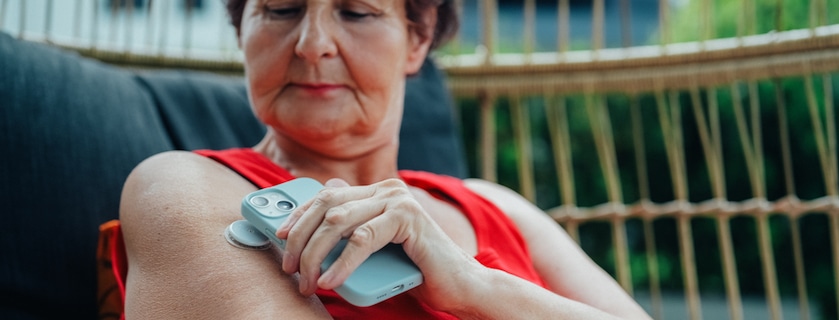
1 in 3, or 30% of Medicare beneficiaries 65 or over have diabetes. That’s more than 22 million people in the United States, of which 3.3 million Medicare beneficiaries are using one or more of the common forms of insulin! Diabetes is also one of the most expensive chronic diseases, and the average Medicare beneficiary with diabetes pays $5,876 for diabetes-related complications alone. But there are standard expenses, too. And ways to save on your plan, supplies, and services.
Discover the top 5 ways to save on Medicare if you’ve been diagnosed with diabetes:
Did you know that there are Medicare Advantage plans tailored to the needs of diabetics? There are! In fact, Medicare Advantage plans serve a higher proportion of diabetic patients than traditional fee-for-service (FFS) Medicare (Original Medicare). Medicare Advantage offers Chronic Condition Special Needs Plans, C-SNPs. Diabetes C-SNP plans provide tailored benefits, out-of-pocket savings, and a personalized care plan.
C-SNP plans for diabetics typically cover blood glucose monitoring, insulin management and diabetes self-management training, nutritional training, and foot care. Most of these plans also offer vision, hearing, and dental care. Your primary doctor, diabetes specialist (endocrinologist), and other healthcare providers work with you to coordinate a personalized plan of care.
Regarding cost, most Medicare Advantage enrollees save $2,000 on average a year in total healthcare spending compared to fee-for-service Medicare (Original Medicare). However, Medicare Advantage C-SNP enrollees with diabetes may save more. C-SNPs tailored to diabetics might have lower copays to see a specialist involved in treating their diabetes. For example, they might pay $20 for most specialists but no copay for diabetes-related treatment from an endocrinologist, cardiologist, podiatrist, or other specialists needed to treat diabetes.
A Medicare Advantage Chronic Condition Special Needs Plan could provide better care coordination at a lower cost. You can review the plan options available in your county by speaking to a local licensed Connie Health agent in your community.
If you have Original Medicare and a Part D plan, you’ve likely begun seeing savings on insulin. The Inflation Reduction Act’s $35 cap makes most insulin more affordable for people on Medicare. Before this policy, Medicare Part D insulin users paid an average of $54 out-of-pocket for a 30-day supply of insulin. Some people paid $100 or more on coinsurance per prescription. The U.S. Department of Health and Human Services reports an average of $500 annual savings with the new cap on monthly insulin.
Similar savings are being seen or implemented with Medicare Advantage Prescription Drug plans. Even if you’re reaping the benefits of this new policy, you should review your Part D or Medicare Advantage plan annually. Plan changes happen every year, and new plans become available. If you allow your plan to auto-renew each year, you may leave premium savings or better benefits on the table, especially if you take multiple medications.
Now, what about anti-diabetic drugs? If your blood sugar isn’t controlled by insulin, it’s likely maintained with anti-diabetic medications. Although not every prescription medication is on every plan’s formulary list, Medicare Part D drug plans may cover the following anti-diabetic drugs:
Again, it’s critical to review your Part D prescription drug or Medicare Advantage plan annually to ensure that your insulin or anti-diabetic medications remain covered and are available at a cost you can afford. You don’t want to try to fill out your prescription – just to find out it’s not covered or has had a big price hike! To review your Part D or Medicare Advantage plan, consult a local licensed Connie Health agent.
Original Medicare Part B and Medicare Advantage plans cover Medicare diabetic supplies such as blood sugar self-testing equipment and supplies, continuous glucose monitors (CGM), insulin pumps, and therapeutic shoes or inserts.
Medicare Part B and Medicare Advantage cover blood sugar self-testing equipment and supplies as durable medical equipment (DME). Self-testing supplies include blood sugar monitors, blood sugar testing strips, and lancet devices and lancets. If you use insulin, you may be able to get up to 300 test strips and 300 lancets every three months. But if you don’t use insulin, you are eligible for 100 test strips and 100 lancets every three months.
Part B and Medicare Advantage plans may cover continuous glucose monitors (CGM) and insulin pumps. These are worn outside the body, like the image at the top of this article. Certain pumps, including the CGMs, are considered durable medical equipment (DME).
Part B covers DME at 80% of the Medicare-approved amount for a CGM or insulin pump. With Original Medicare, you pay 20% of the Medicare-approved amount after the Part B deductible is met. Cost sharing will vary with a Medicare Advantage plan, and if you have a Medicare Supplement plan (Medigap), you may not pay anything out-of-pocket.
Medicare Part B and Medicare Advantage plans will cover therapeutic shoes and inserts if you have diabetes and meet certain conditions. Covered shoes include one pair of depth-inlay shoes and three pairs of inserts, one pair of custom-molded shoes that include inserts if you can’t wear depth-inlay shoes because of a foot deformity, and two additional pairs of inserts.
To be eligible for therapeutic shoes, your doctor must certify that you have diabetes, and you must meet at least one of these conditions in one or both feet:
You must also be treated under a comprehensive diabetes care plan and need therapeutic shoes and/or inserts because of diabetes. A podiatrist or other qualified healthcare provider must prescribe the shoes.
Most diabetic supplies, such as blood sugar self-testing equipment and supplies, continuous glucose monitors (CGM), insulin pumps, and therapeutic shoes or inserts, are covered by Medicare Part B. These Medicare-approved diabetic supplies are covered by Medicare Part B at 80%. After the deductible is met, you pay 20% of the Medicare-approved.
If you have a Medicare Advantage plan, the cost-sharing will vary, and if you have a Medicare Supplement (Medigap) plan, the coinsurance will likely be covered.
Do you need help affording your diabetes medications? According to CMS, in 2020, 28% of all Part D enrollees received either full or partial Extra Help benefits. Full Part D Extra Help, also called the Medicare Part D Low-Income Subsidy (LIS) Program, covers the cost of premiums and deductibles for Part D, and you’ll have lower copayments for medications until you meet catastrophic coverage. After that, you won’t pay any costs.
Agent tip:
“Income qualifications for Extra Help have changed. See if you meet the new income guidelines by speaking with your local Connie Health agent today.“
Thanks to the Inflation Reduction Act, if you currently have partial Extra Help benefits, you may automatically qualify for full Extra Help benefits starting in 2024. And if you’re not receiving Part D Extra Help because you didn’t qualify before – you may in 2024. That’s because the income qualifications have changed. And that’s great news because your prescriptions may be more affordable.
In 2024, the income threshold for full benefits is 150% of the federal poverty level ($21,970 for an individual or $29,580 for a married couple in 2023). Individuals with an income of 135% to 150% of the federal poverty level are eligible for partial Extra Help. That’s between $19,683 and $21,970 for an individual or between $26,622 and $29,580 for a couple). This would entitle you to lower premiums and deductibles than the standard benefit but pay more in premiums and cost-sharing than individuals eligible for full Extra Help. Your resources must be below $16,600 for an individual or $33,240 for a married couple in 2024.
If you’re enrolled in Partial Extra Help, you should be automatically upgraded to full Extra Help if you qualify. However, if you meet the new income guidelines, contact your local Medicare agent to review your plan options and see if you qualify for Extra Help in 2024.
Not everyone accepts Medicare. If you visit a provider or have a service performed by someone who doesn’t accept Medicare assignment, you could be on the hook for the bill. And that could get costly. Instead, you should always check to make sure the provider accepts Medicare. This could save you a lot of money and headaches!
When your doctor, provider, or supplier for diabetic supplies accepts Medicare, your out-of-pocket costs could be less. They’ll charge you only the Medicare deductible and coinsurance amount, and they will submit your claim directly to Medicare for you.
Some doctors or providers who don’t accept Medicare assignment can still accept the Medicare-approved amount on a case-by-case basis. These providers are called “non-participating.” If they don’t accept the assignment, you could pay the full amount at the time of service. They can also charge up to 15% over the Medicare-approved amount for services, but no more than that, and they should submit a claim to Medicare for any Medicare-covered services they gave you.
To avoid the 15% upcharge above Medicare-approved amounts and payment the full amount at the time of service, see doctors, providers, and receive diabetic supplies from those who accept Medicare assignment.
Original Medicare Part B and Medicare Advantage plans cover Medicare diabetic supplies such as blood sugar self-testing equipment (glucose monitors) and supplies. There are limits on how much or how often you can get these supplies.
Some Durable Medical Equipement (DME) is also covered under Part B, including continuous glucose monitors (CGM), insulin pumps, and therapeutic shoes or inserts.
These Medicare-approved diabetic supplies are covered by Medicare Part B at 80%. After the deductible is met, you pay 20% of the Medicare-approved. If you have a Medicare Advantage plan, the cost-sharing will vary, and if you have a Medicare Supplement (Medigap) plan, the coinsurance will likely be covered.
Yes, Medicare covers diabetic supplies. Most diabetic supplies, such as blood sugar self-testing equipment and supplies, continuous glucose monitors (CGM), insulin pumps, and therapeutic shoes or inserts, are covered by Medicare Part B. These Medicare-approved diabetic supplies are covered by Medicare Part B at 80%. After the deductible is met, you pay 20% of the Medicare-approved.
If you have a Medicare Advantage plan, the cost-sharing will vary, and if you have a Medicare Supplement (Medigap) plan, the coinsurance will likely be covered.
Yes, Medicare covers CGM for Type 2 diabetes if your doctor determines that you meet all of the coverage requirements. Part B and Medicare Advantage plans may cover continuous glucose monitors (CGM). These are worn outside the body. Certain CGMs are considered durable medical equipment (DME).
Part B covers DME at 80% of the Medicare-approved amount for a CGM. With Original Medicare, you pay 20% of the Medicare-approved amount after the Part B deductible is met. Cost sharing will vary with a Medicare Advantage plan, and if you have a Medicare Supplement plan (Medigap), you may not pay anything out-of-pocket.
Yes, Medicare covers diabetic test strips. Medicare Part B and Medicare Advantage cover blood sugar self-testing equipment and supplies as durable medical equipment (DME). Self-testing supplies include blood sugar monitors, blood sugar testing strips, and lancet devices and lancets. If you use insulin, you may be able to get up to 300 test strips and 300 lancets every three months. But if you don’t use insulin, you are eligible for 100 test strips and 100 lancets every three months.

Read more by Renee van Staveren
Since 2009, I've been writing about complicated, technical issues, with the goal of making topics like Medicare and healthcare easier to understand. I've been writing about Medicare since 2021 and healthcare since 2019. I am an AmeriCorps alumni. I enjoy gardening, reading, and DIYing.